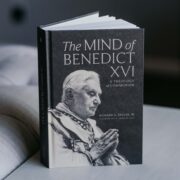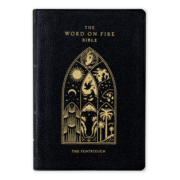During this month of September 2023, which marks the fiftieth anniversary of J.R.R. Tolkien’s death, there have been many commemorations of the great man’s life and work—not least among them Word on Fire Academic’s publication of Holly Ordway’s spiritual biography, Tolkien’s Faith, which I am currently savoring like a pint of good bitter. My own commemoration, here, takes the form of what one might call lectio Tolkieniana. Like lectio divina, lectio Tolkieniana consists in taking a passage from one of Tolkien’s works and “chewing on it” in one’s mind and heart. The passage I have in mind is from The Lord of the Rings, an episode in book 4, chapter 8 where Frodo, Sam, and Gollum, nearing the Enemy’s lair, pause, exhausted and dispirited, high up on the Stairs of Cirith Ungol: “In a dark crevice between two great piers of rock they sat down: Frodo and Sam a little way within, and Gollum crouched upon the ground near the opening.”
The Tales That Really Mattered
“I don’t like anything here at all,” Frodo says to Sam, “step or stone, breath or bone. Earth, air and water all seem accursed. But so our path is laid.”
But so our path is laid.
Frodo has come to see his own life as a path, a path that he has chosen, but not without constraint, a dangerous path toward the goal of destroying the One Ring of power. Sam then begins to “chew on” this insight and to develop it even further.
Surely Frodo and Sam experience the temptation simply to turn around and go home.
“Yes, that’s so,” says Sam. “And we shouldn’t be here at all, if we’d known more about it before we started. But I suppose it’s often that way. The brave things in the old tales and songs, Mr. Frodo: adventures, as I used to call them. I used to think that they were things the wonderful folk of the stories went out and looked for, because they wanted them, because they were exciting and life was a bit dull, a kind of a sport, as you might say. But that’s not the way of it with the tales that really mattered, or the ones that stay in the mind. Folk seem to have been just landed in them, usually—their paths were laid that way, as you put it.”
I said that Frodo and Sam both experience a moment of insight. An insight is the mind’s “sighting” of something that is essential, something that must be the case. What is Sam’s sighting? That his life has taken the form of an adventure story. This is what he “sees” as essential and necessary: that his life has taken on this peculiar narrative shape.
Sam achieves his sighting by connecting his and Frodo’s dire situation with that of the characters in the adventure stories he has heard and enjoyed his entire life. His insight, I argue, is also Tolkien’s insight, and it serves as the cornerstone of Tolkien’s philosophy of stories. One’s life is an adventure story. But what exactly does this mean?
Life as Adventure Story
Let us begin with the idea of story itself, drawing upon a distinction made by the philosopher Francis Slade. As we have seen with Frodo’s quest to destroy the Ring, a story is the account of a protagonist’s pursuit of a goal. To pursue a goal is to execute a purpose or intention. However, a story is not simply a record of a protagonist’s pursuit of some purpose. It is an account of that pursuit against the backdrop of the protagonist’s, and the audience’s, understanding of the end for human beings (an end that Tolkien also attributes to hobbits). The human end is not something that any human being purposes; it is, rather, the completeness or flourishing condition of our nature, a telos that exists prior to our purposes, prior not just in time but, more importantly, in being.
Slade reveals what is essential to story in the following way: “The narrative arts presuppose the ontological priority [the priority in being] of ends to purposes because without that priority there is nothing to be revealed about the adequacy or inadequacy of human purposes to the completeness of human life.”
Frodo and Sam purpose to destroy the One Ring, but as they proceed, both they and we, the readers of The Lord of the Rings, judge whether their purposes are adequate or inadequate to the end of human (hobbit) life. In doing so, we endeavor to achieve our own insight or “sighting” into what is essential and inessential to the human end.

An insight is like a mental diamond: it is formed by great pressure. “There the hobbits took what they expected would be their last meal before they went down into the Nameless Land, maybe the last meal they would ever eat together.” Frodo may still have some hope of destroying the Ring, but he does not have much hope of surviving the ordeal. The pressure upon him and Sam—and Gollum—is tremendous. It exerts all its weight upon their conventional ways of thinking and acting, upon their complacency, upon their expectations, upon all that must be crushed so that what is essential to their end may be revealed. The diamond-like insight formed by this pressure, perhaps especially for Sam, is brilliant enough to inspire not simply a change of mind but a change of life.
But what is an adventure story? In an adventure story, the pressure exerted upon the protagonist comes, firstly, from unusual and exciting external sources: in Frodo’s and Sam’s case, from Sauron and his minions, from Gollum, from all the physical difficulties of their journey, and from the One Ring itself. An adventure story does not exclude internal, i.e., psychological and moral, pressure. Surely Frodo and Sam experience the temptation simply to turn around and go home. But that internal pressure comes about because of the external pressure.
Sam then asks, “I wonder what sort of a tale we’ve fallen into?” He seems to be asking not whether he and Frodo have fallen into an adventure story, but whether in their adventure, they will achieve their purpose and survive the effort.
Frodo remarks that the people inside the tale don’t know how the tale will end. The ending that will manifest the final adequacy or inadequacy of their purposes to the human (hobbit) end has not yet been achieved. In the depths of the Inferno, Dante does not feel that he is in a comedy. And neither on the Stairs of Cirith Ungol do Frodo and Sam feel they are in a quest story that will have the most magnificent of eucatastrophic endings. To live one’s life as an adventure story is to live, to some degree, uncertain of how things will turn out.
We’re in the Same Tale Still!
Sam then has a second insight. He connects the light in the star-glass that Galadriel gave Frodo in Lothlorien to the light of the Silmaril that Beren stole from the Iron Crown in Thangorodrim and that eventually came to Eärendil. His life-as-adventure now becomes his life-as-connected-to-a-foundational-story-of-Middle-earth.
Here we have an instance, according to Tolkien scholar Tom Shippey, of the literary quality Tolkien prized the most: depth. Tolkien loved for his stories to reveal layers of backstory, and Tolkien loved to write these layers of backstory himself, often with several attempts at the same story (Shippey counts in Tolkien’s writings nine different versions of “The Legend of Beren and Lúthien”). Tolkien obviously felt that this narrative depth lent to his stories a rich mimetic reality.
For Sam and Frodo as well as for us, the desires for romance and truth have been justified and reconciled in their taking part in the one great tale.
Why is Sam’s second insight so important? Because in connecting his and Frodo’s own adventure to the adventures of Beren and Eärendil, he has a “sighting” of his and Frodo’s adventure as a participation in the great adventure of Middle-earth. “Don’t the great tales never end?” Sam asks in astonishment at this realization.
Here is where Tolkien’s philosophy of stories achieves its own depth. But in order to reveal the depths of Tolkien’s philosophy, I need to bring in some ideas from a man Tolkien much admired, G.K. Chesterton.
In his book The Everlasting Man, Chesterton speaks of two crucial needs we human beings have: a need for romance and a need for truth. Our need for romance is nourished in part through stories, not least adventure stories. Our need for truth is nourished by “philosophy”—understood not merely as the specific academic discipline that relies solely upon the natural light of reason but very broadly as any account of life’s meaning. In his 2007 encyclical Spe Salvi (Saved in Hope), Pope Benedict XVI refers to this broad understanding of philosophy when he talks about the sarcophagi in the early Christian era as depicting Christ holding the philosopher’s customary staff. Christ was depicted as philosopher, Pope Benedict says, because he taught what Benedict calls the essential art, “the art of being authentically human, the art of living and dying.” Return now to Chesterton. We want both romance and truth. And, Chesterton argues, our Faith—the highest and best “philosophy”—unites both of these desires.
Using the same broad sense of “philosophy” that Pope Benedict uses, Chesterton elaborates upon this insight:
The Catholic faith is a story and in that sense one of a hundred stories; only it is a true story. It is a philosophy and in that sense one of a hundred philosophies; only it is a philosophy that is like life [i.e., like an adventure story]. But above all, it is a reconciliation because it is something that can only be called the philosophy of stories. That normal narrative instinct which produced all the fairy tales is something that is neglected by all the philosophies—except one. The Faith is the justification of that popular instinct [for romance, for adventure]; the finding of a philosophy for it or the analysis of the philosophy in it.
Chesterton goes on to make the explicit connection between an adventure story and the story of the Faith: “Exactly as a man in an adventure story has to pass various tests to save his life, so the man in this philosophy has to pass several tests to save his soul.” He then anticipates Slade in describing both the adventure story and the Christian story as an interplay of purpose and end: “In both there is an idea of free will operating under conditions of design; in other words, there is an aim [in the sense of end] and it is the business of a man to aim at it; we therefore watch to see whether he will hit it.”
I propose that Chesterton’s insight here is akin to Sam’s insights on the Stairs of Cirith Ungol. Just as Sam connects his and Frodo’s adventure first to adventure stories in general and then to the foundational adventure stories of Middle-earth, so too Chesterton connects adventure stories to our participation in the foundational story of Christ’s mission of redemption. For Sam and Frodo as well as for us, the desires for romance and truth have been justified and reconciled in their taking part in the one great tale.
Fairy-Stories and Learning How to See Again
But, if Tolkien is right, our need for romantic storytelling requires not just any kind of adventure. Indiana Jones and Tom Cruise’s Ethan Hunt won’t give us the full nourishment we need. For that we need fairy-stories, myths of perilous and enchanting secondary worlds.
For Tolkien’s ideas on the power of fairy-stories I rely on his famous essay, “On Fairy-Stories.” There, Tolkien argues that a fairy-story is the best mode of storytelling: “But when [fairy-stories] are attempted and in any degree accomplished then we have a rare achievement of Art: indeed narrative art, story-making in its primary and most potent mode” (emphasis added).
Tolkien takes fairy-stories as the primary mode of storytelling for three reasons: for their unsurpassable ability to recover or reawaken a sense of wonder at the “simple or ordinary things,” the essential things of life; for their ability to afford escape from the ugliness of a modern world encased by technology; and for their ability to imaginatively help us satisfy “old ambitions and desires,” such as flying or talking to animals.

But then Tolkien adds a fourth reason for the primacy of fairy-stories: the fact that they offer the consolation of the happy ending. If tragedy is the true form of drama, the eucatastrophe—the “good catastrophe,” “a sudden and miraculous grace”—is the highest form of the fairy-story. Though the fairy-story, Tolkien writes that the fairy-store “does not deny the existence of dycatastrophe, of sorrow and failure, [as] the possibility of these is necessary to the joy of deliverance; it denies (in the face of much evidence, if you will) universal final defeat and in so far is evangelium [“good news”], giving a fleeting glimpse of Joy, Joy beyond the walls of the world, poignant as grief.”
Because of their eucatastrophic endings, most of all, fairy-stories do better than any other kind of story in anticipating the Christian story—which reminds us that the Christian story just is a fairy-story. Fairy-stories, in other words, are the foremost imaginative means of putting pressure on our hobbit-like complacency so that we might have the diamond-like insights that freshen our minds and hearts dulled (it is terrible to admit) to the fairyland of the Gospels.
In the evocative phrase of the philosopher Josef Pieper, fairy-stories helps us to “learn how to see again,” to see that our own life is marvelous and exciting and ultimately Joyful, more marvelous and exciting and ultimately Joyful even than The Lord of the Rings.
